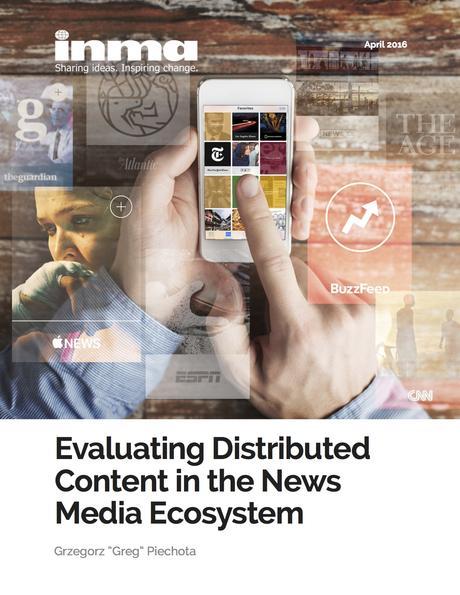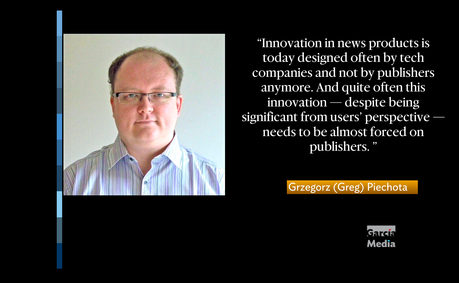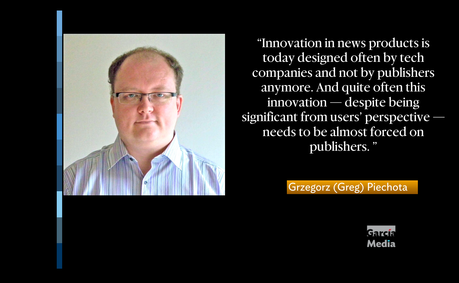

Cover of the report, as published by INMA (International Newspaper Marketing Association)
It was early fall 2015 and I was happy to welcome Grzegorz (Greg) Piechota into my New York home for a visit. The conversation centered around his arrival in the US, with his family, to start his Nieman Fellowship at Harvard—a yearly program where seasoned journalists come to sharpen their skills, to study ways to improve the craft and to come up with solutions for problems and situations affecting newsrooms.
While Greg did not have a very clear idea of what his Nieman project would be, I could tell that he would have a successful year and that his contribution would be grand.
I was not wrong.
This past week, Greg’s research paper, Evaluating Distributed Content in the News Media Ecosystem, was published by INMA (International Newspaper Marketing Association) and it is jam packed with thoughts that need to be centerpieces of discussion at newsrooms everywhere. It is a highly insightful report, with some thought-provoking conclusions and plenty of sensible advice.
I spent time discussing the report with Greg, who served as news editor of Gazeta Wyborcza in Warsaw, Poland., and asked him some questions that I want to share with you. Greg explained that the research for his report was inspired by his studies on digital transformation and innovation at Harvard. He added that although the report is not about editorial design, it touches many issues at the core of product development.
A conversation with Greg Piechota




This is the Walter Lippmann House in Cambridge, Mass., headquarters for the Nieman Foundation for Journalism at Harvard
Mario:
In your report you discuss the need for cooperation and competition when it comes to social media. And we know (many of my clients have the proof) that a large number of the audience comes to a newspaper website VIA social media, a link. And it is hard to retain these readers to stay and read a second story. As a result, do you feel that the home page as we know it is going the way of extinction?
Greg:
I think that the saddest thing you see is that a lot of innovation in news products is today designed by tech companies and not by publishers anymore.
And quite often this innovation—despite being significant from users’ perspective—needs to be almost forced on publishers. Why did we need Google, or Facebook to tell us how crappy the user experience was on mobile?
I think this sadly illustrates how deeply disrupted and weakened the industry is.
Mario:
Greg, what do you suggest publishers should do?
Greg:
I believe we need to take back our future: we cannot outsource user experience. We need to innovate more to provide experiences people don’t find on platforms.
The user of your own website is more valuable than the user on other people’s platforms. You own the relationship. You can build new services and experiences on that.
Examples: Facebook has introduced Live video, Twitter has it for some time. But some publishers like VG (of Norway) know that video stream is not enough—you can create more sophisticated experiences when the live stream is accompanied by live text reports and a social layer of discussion.
Despite the growth of social media, homepage still is one of the most profitable products news publishers have. It’s a destination that many people recognize and use frequently, especially on the desktop.
It’s also in the best interest of publishers to convert a visitor coming from a social platform, into a user—so story pages should in fact become extended portals to the rest of the publication.
I think you have said many times that today a publisher has hundreds of front pages. I totally agree.
The challenge is how to stay or become a destination in mobile. 90% time on a phone users don’t browse but use apps.
Mario:
How about apps?
People tend to use just a few apps. Realistically, we build news apps not for broad audiences but the for the most loyal and most engaged users. This might be a big insight for designing these apps.
Mario:
What next for you as you leave Harvard and return to Poland?
Greg:
I am still working on two research projects that I aim to finish by this summer.
One is about the future of work in our industry. The job market is shifting towards on-demand model: in Europe 40% journalists are freelancers today and in some countries like Germany it’s already 60%. The big question is when a digital platform like Facebook becomes an “uber for journalists” that will further disrupt news publishing industry?
My other research is about solution-oriented news engagement. I am working on frameworks and work-flows that would allow media to assemble and guide communities to spark social change ideas and find solutions to the biggest problems of our time. Inequalities, migrations, political and religious extremism—I believe we, the media, must help communities address all that.
Highlights of the report
About innovation:
“Innovation in news products is today designed often by tech companies and not by publishers anymore. And quite often this innovation — despite being significant from users’ perspective — needs to be almost forced on publishers. I think this really illustrates how deeply disrupted and weakened the industry is. Our value chain is under assault, but we seem to be happy to outsource everything, even our future.”
Successful publishers:
“Publishers whose content enjoys the highest reach and engagement on social platforms have dedicated teams that repurpose and produce content tailored to specific platforms, their audiences, contexts of use, and styles. Just to prepare for Snapchat Discover, magazine publishers have built newsrooms of up to 10 full-time employees: editors, video editors, and graphic designers. CNN’s team has three members; The Wall Street Journal, five; the Daily Mail, eight; and Refinery29, a magazine for female millennials, 10. Social video operations employ many more: There are 35 people on the video team at Elite Daily, a millennial site, and more than 100 at BuzzFeed.”
Platforms:
“Think about platforms as fishing places where you can find large, engaged audiences and build a relationship with them by providing content. Then offer these users some other services off-platform.”
Of related interest
http://www.niemanlab.org/2016/04/newsonomics-in-the-platform-wars-how-well-are-you-armed/
Getting the report
The report is free to INMA’s 7,000-plus members, it costs $695 retail.
For details go http://www.inma.org/blogs/main/post.cfm/new-inma-report-evaluates-distributed-content-opportunities-for-media-companies

